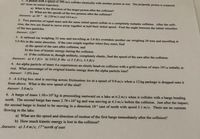
College Physics
11th Edition
ISBN: 9781305952300
Author: Raymond A. Serway, Chris Vuille
Publisher: Cengage Learning
expand_more
expand_more
format_list_bulleted
Question
Please solve 1A and 1B

Transcribed Image Text:### Educational Website Content
#### Physics Problems on Collisions
1. **Proton Collision**
- A proton with a speed of 500 m/s collides elastically with another proton at rest. The moving proton is deflected by 60° from its original path.
- a) Determine the direction of the target proton after the collision.
- b) Calculate the speeds of both protons after the collision.
- **Answers:**
- a) 30°
- b) 250 m/s and 433 m/s
2. **Inelastic Collision of Equal Masses**
- Two particles of equal mass and the same initial speed collide in a completely inelastic manner. After the impact, they move together at half their initial speed. Find the angle between their initial velocities.
- **Answer:** 120°
3. **Railroad Car Collision**
- A 32-ton railroad car traveling at 5.0 ft/s overtakes a 24-ton car traveling at 3.0 ft/s in the same direction. Upon coupling, determine:
- a) The speed of the cars post-collision.
- b) The kinetic energy lost during the collision.
- c) If an elastic collision occurs (though unlikely), find the speed of the cars post-collision.
- **Answers:**
- a) 4.1 ft/s
- b) 2332 ft-lbs
- c) 5.3 ft/s, 3.3 ft/s
4. **Alpha Particle Collision**
- An alpha particle with a mass of 4 u collides elastically with a gold nucleus of mass 197 u at rest. What percentage of its initial kinetic energy does the alpha particle lose?
- **Answer:** 7.8% loss
5. **Box Sled and Package Collision**
- A 6.0 kg sled slides on frictionless ice at 9.0 m/s. A 12 kg package is dropped vertically onto it. What is the sled’s new speed?
- **Answer:** 3.0 m/s
6. **Barge Collision**
- A barge with mass 1.50 × 10⁵ kg moves eastward at 6.2 m/s and collides with a north-heading barge. The second barge (2.78 × 10⁵ kg) travels at
Expert Solution
This question has been solved!
Explore an expertly crafted, step-by-step solution for a thorough understanding of key concepts.
This is a popular solution
Trending nowThis is a popular solution!
Step by stepSolved in 4 steps with 4 images

Knowledge Booster
Learn more about
Need a deep-dive on the concept behind this application? Look no further. Learn more about this topic, physics and related others by exploring similar questions and additional content below.Similar questions
- A plane takes off from an airport and flies to town A, located d₁ = 340 km from the airport in the direction 20.0° north of east. The plane then flies to town B, located d₂ 210 km at 30.0° west of north from town A. Use graphical methods to determine the distance and direction from town B to the airport. (Enter the distance in km and the direction in degrees south of west.) km o south of west - distance directionarrow_forward4 m -7 m F = 900 N 2 m B 2 marrow_forwardCan you solve d and e Thanksarrow_forward
- y (NOT IN SCALE) With Cartisian coordinates, express a force vector F, where O1 30° (y axis to thin black line), c= 4, d 3 and F = 440 lb. F = i + j+ k lb.arrow_forwardYou start on the origin and walk in a strait line to a point that is 10 m east and 25 m north of where you started. From there you walk 3 m west and another 10 m north, Write each location in terms of vectors A and B. Use vector addition as well.arrow_forwardConsider the following 2 vectors: A =1.42 m 27.2° B =4.63 m 56.8° The angles in the above formulas are the standard angle. What is A· B? Please express your answer in m2 to 3 significant figures.arrow_forward
- On his trip from home to school, Noah Omwerk drives along three streets after exiting the driveway. He drives 1.85 miles south, 2.43 miles east and 0.35 miles north. Determine the magnitude of Noah's resultant displacement. And the angle from East to South.arrow_forwardGg to get to his office from home, greg walks 6 blocks north and then 3 blocks east. after work he meets some friends at a cafe; to get there he walks 3 blocks south and 6 blocks west. all blocks are 660 ft long. what is the straight line diatance from the cafe to his home?arrow_forward
arrow_back_ios
arrow_forward_ios
Recommended textbooks for you
 College PhysicsPhysicsISBN:9781305952300Author:Raymond A. Serway, Chris VuillePublisher:Cengage Learning
College PhysicsPhysicsISBN:9781305952300Author:Raymond A. Serway, Chris VuillePublisher:Cengage Learning University Physics (14th Edition)PhysicsISBN:9780133969290Author:Hugh D. Young, Roger A. FreedmanPublisher:PEARSON
University Physics (14th Edition)PhysicsISBN:9780133969290Author:Hugh D. Young, Roger A. FreedmanPublisher:PEARSON Introduction To Quantum MechanicsPhysicsISBN:9781107189638Author:Griffiths, David J., Schroeter, Darrell F.Publisher:Cambridge University Press
Introduction To Quantum MechanicsPhysicsISBN:9781107189638Author:Griffiths, David J., Schroeter, Darrell F.Publisher:Cambridge University Press Physics for Scientists and EngineersPhysicsISBN:9781337553278Author:Raymond A. Serway, John W. JewettPublisher:Cengage Learning
Physics for Scientists and EngineersPhysicsISBN:9781337553278Author:Raymond A. Serway, John W. JewettPublisher:Cengage Learning Lecture- Tutorials for Introductory AstronomyPhysicsISBN:9780321820464Author:Edward E. Prather, Tim P. Slater, Jeff P. Adams, Gina BrissendenPublisher:Addison-Wesley
Lecture- Tutorials for Introductory AstronomyPhysicsISBN:9780321820464Author:Edward E. Prather, Tim P. Slater, Jeff P. Adams, Gina BrissendenPublisher:Addison-Wesley College Physics: A Strategic Approach (4th Editio...PhysicsISBN:9780134609034Author:Randall D. Knight (Professor Emeritus), Brian Jones, Stuart FieldPublisher:PEARSON
College Physics: A Strategic Approach (4th Editio...PhysicsISBN:9780134609034Author:Randall D. Knight (Professor Emeritus), Brian Jones, Stuart FieldPublisher:PEARSON

College Physics
Physics
ISBN:9781305952300
Author:Raymond A. Serway, Chris Vuille
Publisher:Cengage Learning

University Physics (14th Edition)
Physics
ISBN:9780133969290
Author:Hugh D. Young, Roger A. Freedman
Publisher:PEARSON

Introduction To Quantum Mechanics
Physics
ISBN:9781107189638
Author:Griffiths, David J., Schroeter, Darrell F.
Publisher:Cambridge University Press

Physics for Scientists and Engineers
Physics
ISBN:9781337553278
Author:Raymond A. Serway, John W. Jewett
Publisher:Cengage Learning

Lecture- Tutorials for Introductory Astronomy
Physics
ISBN:9780321820464
Author:Edward E. Prather, Tim P. Slater, Jeff P. Adams, Gina Brissenden
Publisher:Addison-Wesley

College Physics: A Strategic Approach (4th Editio...
Physics
ISBN:9780134609034
Author:Randall D. Knight (Professor Emeritus), Brian Jones, Stuart Field
Publisher:PEARSON